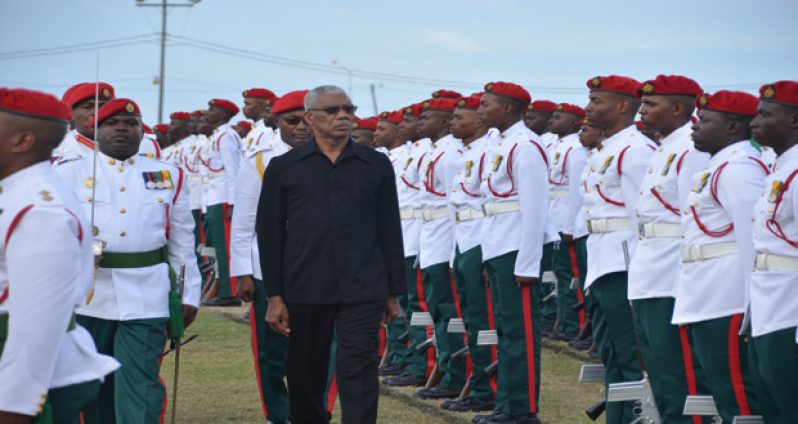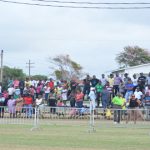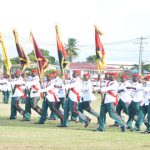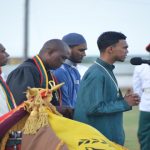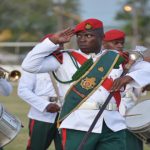THE playfield of Base Camp Ayanganna was yesterday the scene of an intriguing spectacle as stately soldiers, neatly dressed and aligned, marched in rhythm to the beat of drums.
The occasion was the Force’s colour parade which was part of activities to celebrate its 50th anniversary being observed under the theme: “Commemorating the past. Celebrating the present. Carving the future”.The parade started on time on a generally cool afternoon. Shortly after the arrival of His Excellency Brigadier (Rt’d) President David Granger, all in the crowd got out of their chairs and stood at attention. The President then strode to the dais for the presidential salute.
The soldiers who put on the show were all bedecked in white shirts, green pants with red stripes and red berets. They were from the five units of the 50-year-old army – Infantry Battalion, 2nd Infantry Battalion Reserve, Base Camp Ayanganna, Base Camp Stephenson and Engineers Battalion.
Smart attired, some soldiers carried guns, some had drums while others had swords, but all were moving like a symphony.
President Granger, on taking the salute, was invited to inspect the guards on the tidy, verdant field, and on completion of the inspection, the custodians of the colour appeared and entered.
With the coloured flags of their units fluttering in the afternoon sea breeze, they marched elegantly, carrying them proudly, to the beat of drums and the blowing of trumpets.
The civilian spectators on the ground looked in awe while the soldiers in the crowd stood and saluted.
After a brief march, the drums ceased and were assembled at a 90 degree angle to the dais. It was time for consecration of the colours. The sun dimmed and cool breeze blew gently across the ground. The Defence Force Chaplain and priests from the Christian, Hindu and Muslim communities then offered their prayers. It was a warm but stately atmosphere.
When the prayers were completed the colours were handed back to their bearers and the drummers, in quick strides, marched quickly back into their positions.
And soon after, the drumming and the trumpets were heard again as the colour custodians again began their march in uniformity.
In their lively show, marching both slowly and quickly, they saluted the President as members of the Cabinet, diplomatic corps, top brass of the security forces and the public looked on.
They were the first to march off the field and were quickly followed by the other men in white shirts, green pants and red berets.
They both departed the field to resounding applause from the gathering.
Civilians came out in full numbers to see the parade and they all left contented and with a deep spirit of patriotism.
The colour parade has a long and colourful history. From earliest times, combatants carried into battle some token to serve as identification and a rallying point in the field. The form of token varied throughout the world.
However, in England during the period of conflict with Spain, commanders of regiments who were not noblemen and therefore had no Coat of Arms, used tokens of colours to identify their commands. These tokens took the shape of flags and became known as ‘colours’.
The colours were taken into battle by ‘Ensigns’ in positions from which they could easily be seen and recognised. They became the centre of the bitter fighting and many deeds of heroism and self-sacrifice to prevent the capture of ‘colours’ are recorded.
Colours are no longer carried into battle in response to the changing circumstances of war. However, they remain the symbol of the spirit of the regiments, and the ceremonial tradition associated with them has been preserved.
In Guyana, the British Guiana Volunteer Force received both its own Regimental Colours and the Queen’s Colours. The Regimental Colours of the Guyana Defence Force was presented after consecration on Sunday, October 29, 1972 by then Prime Minister and Minister of Defence Linden Forbes Sampson Burnham.
The State Colours were consecrated and presented to the Guyana Defence Force on Tuesday, October 29, 1985 by then President and Commander-in-Chief Desmond Hoyte.
By Tajeram Mohabir



.jpg)




